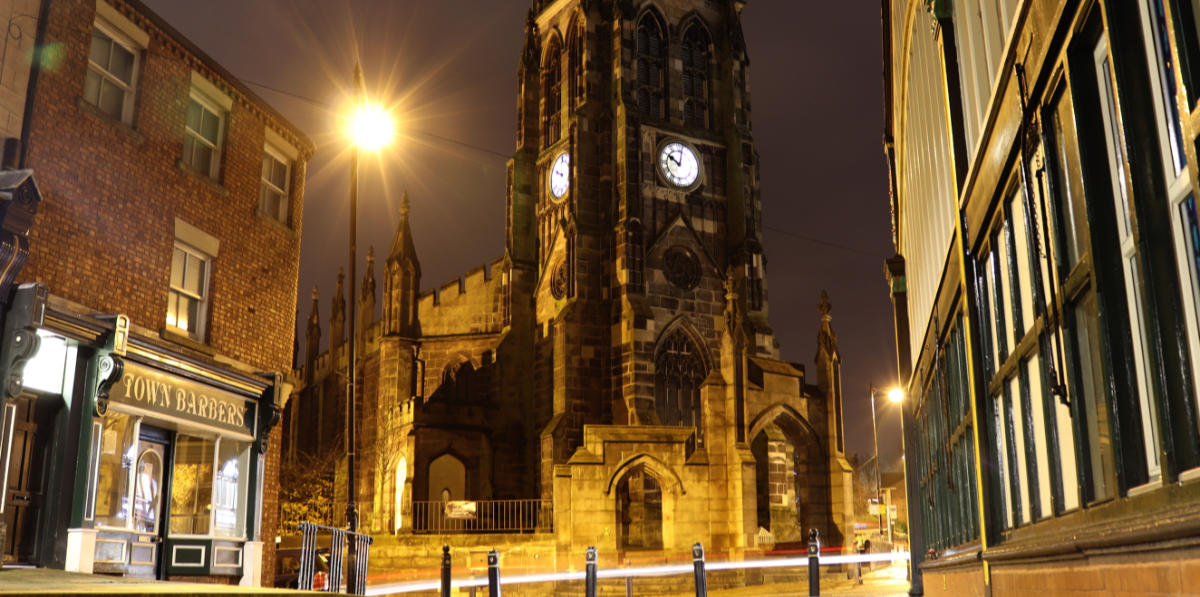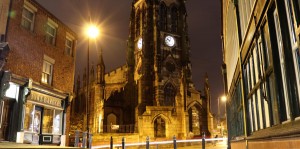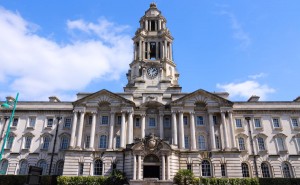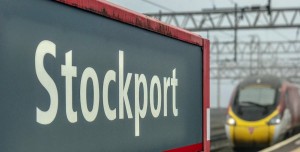
The Five-Minute Guide to Stockport Greater Manchester’s hidden gem.
Modern-day Stockport is a town big enough to rival any city. With more than 114k residents, it’s big enough to sprawl from Lancashire to Cheshire. Once known as an international hemp producer, rope-making town, and hattery, this place has bags of character and enough appeal for any staycation wanderer.
Before you pack your bags ready to go visit Stockport’s many attractions, let’s recap on about a thousand years of history. It’s always interesting to learn what formed the town…
Early Stockport History
There have been traces of people in Stockport since the Mesolithic period, which ended roughly 5500 years ago. They left behind tools, funeral urns, and pictures featuring hunting successes. Archaeologists report a thousand-year gap before the Romans came in 70AD, which looks a lot like a period without occupancy. The name comes from the Old English, where a ‘stok’ was a small town and a ‘port’, which indicated it was made of wood.
When the Romans did arrive, nobody knows if they stayed here or not. We do know that the Roman roads connecting other places passed through the town, nearly in the centre, so it makes sense that the area would have seen people passing through occasionally. Despite a lack of solid evidence of Roman settlement, coins have been found buried here, near the banks of the Mersey. Similarly, a fjord in the river meant that it would have been a passing place for Roman riders.
Post Romal Times
The post-Roman years are largely unaccounted for in Stockport. Coins from King Edmund (939-946) were found in a field in the 18th century, indicating that the area was still populated after the Romans left. Nearby Manchester has shown some evidence of Viking invasions, but Stockport shows little evidence of this. It is possible that the villager’s proximity to Manchester saved them from raiding.
By the time of the Norman invasion, Stockport was almost uninhabited. It is not mentioned in the Domesday survey at all. This means it was too small to note, or that it fell into someone’s land and wasn’t more than woods or fields. After the Normans invaded, the people in the north protested so much that William the conqueror sent his armies to deal with them. This was known as ‘the harrying of the north’. Whole towns were extinguished. Stockport – already a market town before then – was likely one of these.
The town was definitely inhabited in the late 12th Century though as St.Mary’s Church pictured below has stood here is one guise or another since 1190.

Image:Steve G Parker/Shutterstock.com
Medieval Stockport
The town has recorded the presence of a castle a hundred years after the Normans landed. It was used as a stronghold against king Henry II. The castle was small and wouldn’t have lasted much longer than the 16th century before it fell into ruin. It was eventually levelled and replaced with Warren’s Mill. They gained a charter in 1260 that gave them the right to hold a weekly market and an annual fair.
The bridge was built in 1282 and the town continued to be a slow-growing market town. It was famous for hats (from the 16th century), produced cattle, leather, and meat, contained a blacksmith, and eventually became a cotton-weaving town. In 1487, a grammar school opened in town.
During the English Civil War, Stockport supported the Parliament. The man who would try the king was born and educated here. In 1644 Prince Rupert attached the town with men and cannon, which were still unreliable back then. The Prince was successful and marched on through. He would later fall at Marston Moor. There were two plague outbreaks in 1606 and 1665.
The bridge was dismantled to try and stop Bonnie Prince Charlie from marching on Derby. There was a brief skirmish between the town guard and his army before they marched on past. Of further note was a date in 1784, when a farmer tried to avoid a tax on horses in town by riding an ox, instead.
Stockport became a focus of industry from the mid-16th century, earlier than most towns. This was due to the demand for Stockport hats, which were being exported to Manchester and thus on throughout the known world.
Before we get into the ins and outs of the Industrial age in Stockport, let’s take a break to talk about trivia from in and around town.
Fun Stockport Trivia
We love finding out the facts about the towns that we research, and Stockport is no different. We dug up the best Stockport trivia according to the team here at Five Minutes Spare. Use it to delight people at parties or to mesmerize your friends. You can thank us later.
- It’s estimated that Stockport sent more than 6 million hats, all over the world. The same business that began back in the 16th century, didn’t close its last store until 1998. Hats have been the bread and butter of Stockport for over four hundred years…
- Stockport Viaduct attracts thousands every year. It’s suave, sophisticated, and helps hold up the railway to this day. It was built in 1840 when the railway first made it to the area. It features 27 arches that help trains traverse the river. They say it features more than 11 million bricks.
- Both Joy Division and the Stone Roses hailed from Strawberry Studios, Stockport’s own music production studios. They closed in 1993.
- Robinson’s Brewery was founded in Stockport in 1849 and distributes 13.3 million pints of beer annually.
- They call their football team ‘the hatters’ due to their association with the hat industry.
You see? There are loads of things that make Stockport stand out from the other large towns in the Greater Manchester area. We’re not done yet, either. There’s still lots of interesting things to find out.
Let’s get on with it.
Industrialization in Stockport
Let’s not forget the glaring flaw in the export of 6 million hats from the 1500s onwards. The lead and mercury they would use in the production of the hats would make people go mad with poisoning. Silk was also made here later in the 17th century and would have been added to the fuel for the hat fire. Cotton became a huge product here, as did all things that could be used as fabric for hats.
There were huge problems with silk weaving here in the UK. We had to import the thread from Italy all the way up to the 18th century. A man travelled to Italy, stole the design of their machines, then patented it. When he tried to renew the patent, silk manufacturers in town petitioned against him and the design was made available to all. Mills opened all over the place as a result. The first silk mill in 1732 in Stockport… the first in the northwest.
In 1700 the population was roughly 2000 people. By 1780 it had 2000 people working in the silk mills, with 5000 population. By 1801 this number was tripled and more, to 14,000 people. Although silk production died out by the end of the 18th century, the rise in cotton production took over. The canal was built in 1797, with the railway coming in 1840. There were cholera outbreaks in 1832 and 1849. The waterworks opened in 1827 with a gas company formed 7 years before. 1880 saw horse-drawn trams in the town and an infirmary was built in 1833.
By the beginning of the 19th century, hat making had taken over all but the cotton industry. An armoury was built in 1862. In the early years of the 20th century, there was 3000 hat-making employees, with factories still existing right up until 1997.
20th Century Stockport

Stockport Town Hall Image:Tupungato/Shutterstock.com
In 1908 Stockport got its own town hall, followed by a 1912 cinema. The library was added in 1913.
They took part in the PALs regiment scheme, losing thousands as a result.
The first council houses weren’t built until after WWI.
During WWII, Stockport suffered some intense bombing, probably due to the proximity of Manchester Airport. A set of shelters were opened in 1939 and are still operational to this day. There are a series of interconnected tunnels under the town, sometimes open to tours. The labyrinth of tunnels could hold 6,500 people. They re-opened to tourists in 1996.
Post War
A shopping mall was built in 1965 but the town centre was damaged two years later in an air accident. Considered one of the worst air accidents in British history, the Stockport Air Disaster saw a passenger aircraft crash near the town centre. 72 of the 84 people on board were killed. Nobody on the ground was hurt. In fact, local people managed to rescue 12 passengers before the wreckage exploded, killing anyone else who was left alive.
It was a sad day in the history of a town known for good nature and a touch of madness. Stockport was rocked by the disaster. Since it was a Sunday, a huge crowd grew. Rescuers were stopped from accessing the site, making matters worse.
The town centre was eventually refurbished in the mid-90s. Since the second world war, the town has seen extensive council housing added, extensions of the tourist industry and retail developments all added to it. It has grown from strength to strength as a quaint tourist town on the River Mersey, and as a great commuter town from Manchester. It’s a modern hub of diversity, bustling offices, and shopping malls… but it never lost its northern charm.
In 2018, Stockport celebrated 100 years since the end of WWI. The centenary was marked by remembrance ceremonies and art installations. The roll of honour has 2,162 young men’s names in it, and all from the town itself.
Before we jump into the attractions with both feet, we still have one more category to cover. Let’s talk about famous people from Stockport, and who you might recognise while you are out buying teabags.
Famous People from Stockport
Some of our favourite famous faces from Stockport are as follows:
- Claire Foy, an actress from ‘the Crown’ is Stockport born.
- The drummer from 10cc, Paul Burgess, is from here.
- David from ‘the Royle Family’ was born here.
- Tess Daily, English model and TV presenter.
- Nigel Harrison from Blondie was born here, as was the drummer from Muse.
The list goes on and on. For being so far up in the north, they have an inordinate amount of famous people. If you are spending any time there, you should definitely keep your eyes peeled down Sainsbury’s.
Attractions in Stockport
We have arrived at everyone’s favourite part of our town reviews… the tourist attractions. As tourism is a major player in Stockport, we expect this to be awesome. Here are all the things you should see and do in town, this holiday season.
Historic Sights and Landmarks
The Robinson’s Brewery is a favoured attraction in town. not technically a landmark, it is a historic site in town. This same brewery has been making beer Although in Stockport for generations. They still have some of the old methods of brewing that make their beer so distinctive. They also operate several pubs, so they distribute a lot of beer.
Next in the list of unconventional historic attractions in Stockport, we have those weird air raid shelter tunnels. Situated underneath the entire town, these long tunnels would have housed civilians during the war. You can experience what it was like to live during a blackout and get a guided tour.
You absolutely cannot come to the industrial age centre of hat-making without paying a visit to the Hat Works Museum of Hatmaking. It would be folly to miss it out. Don’t worry, they stopped adding mercury to the hats about a hundred years ago now. Still, we wouldn’t lick anything. The museum itself has exhibits focused on the production of hats through the ages. They talk you through the stages of fabric use, how to make the hats, and how many people went crazy, making and wearing them.
Yet another museum in town is the Staircase House. This is a perfectly preserved, reportedly haunted, home that has been immaculately restored. First built in the 1400s, the Staircase House is a testament to life in Stockport through the years. They have some neat audio tours which let you keep your privacy while you wander around. It is situated on the edge of the 14th-century marketplace, too, so you can nip out to the shops afterwards.
Outdoor Attractions
The Etherow Country Park is a top attraction, drawing hundreds of visitors a year. There is a lovely meadow, a duck pond with some of the best fed ducks in England, loads of walks to take, and nature trails that point out the different things to see in the forest. They have some gorgeous, staggered falls in the river there. It gets busy at weekends. You will find it just outside of town in a village called Compstall.
A great place for taking the kids when on holiday in Stockport, Reddish Vale Farm contains everything from guinea pigs to horses. Kids get a chance to learn all about farm animals up close, while also petting them when safe to do so. The farm is arguably best visited in Spring when the chicks and baby bunnies arrive. So cute! They run regular events and even a riding school.
Take a tour of Brookside Garden Centre in nearby Poynton and admire the plants. There is a lovely outdoor play area for the little ones, with a tiny train running throughout. Peruse seasonal plant arrangements and buy garden furniture. Visit during Halloween for a pumpkin patch, or during Christmas with trees. You can even enjoy a high tea at their café and let the kids play free.
Have a wander around the Marple Locks of a fine summer’s day. Get some ice cream, visit the café, enjoy the ducks and swans, or just take the kids for a walk. It’s filled with sunbathers during summer.
Galleries and Museums
There is a museum in Stockport with an air raid bomber perched outside, effectively making it half landmark. Avro is a heritage museum in Stockport that is dedicated to all things aviation. It features a flight simulator, a WWII blackout experience, contains a café, and has a sub-hunting experience. You can get in and about the aircraft, too. This place is a firm favourite with kids and school groups.
If you are in Stockport researching the family history, or if you have a special interest in the Industrial Era, you can visit the Stockport Museum. They have all there is to know about the town, the artefacts found in it, and the ancient history of the land. Check it out.
Sports and Recreation
We don’t usually put the time into describing theatres in these articles. Everyone can Google where to see a movie easily enough. However, The Plaza theatre in Stockport gets a special mention. This place has been in operation since the late 19th century and has seen almost continuous use since then. It is the only building of its design that is still seeing use for the purpose it was built for in all of England…maybe even in the world.
There are several sports facilities in town. There are plenty of gyms and fitness centres, but it is the Hatters that draw in the crowds. You will find them in Edgeley Park, where they have played since 1902. Catch a game, take a tour, or otherwise support Stockport County FC by going along and giving them a visit.
Like any other English town, there are at least two golf clubs within a ten-mile radius of Stockport. There is the imaginatively named Stockport Golf Club, the Hazel Grove Golf Club, or the Heaton Moor Golf Club for you to choose from.
Shopping and Retail
There are several places you can go to enjoy some retail therapy. Shopping in Stockport is best done at the Merseyway shopping centre, the Hauldsworth Mill Shopping Centre just outside of town, or the Court Shopping Centre in the centre of town. Stockport even has its own retail park.
Other Notable Attractions in Stockport
Of course, there is more to do in this town than we were able to fit into one article. Here are all the second-best bits to see and do, that we just couldn’t go into in better detail:
- There is a second farm in town to take the kiddies to. Have a look at the Garden House Marple place, where they grow greens and fruits.
- Head out to the Reddish Vale Country Park which surrounds the little farmyard there.
- Visit Bramall Hall and Park to browse some gorgeous gardens and enjoy a stately Tudor mansion.
- The Woodbank Memorial Park has its own café and a nice view.
- Visit the Roman Lakes, we’re not sure how they got their name.
- The religiously inclined can head to the Chadkirk Chapel Museum, a beautiful place of prayer and reflection.
There are so many attractions in Stockport that we are amazed anyone ever leaves it. Go along and see for yourself. We bet you won’t want to go home again.
How to Get to Stockport

Image: Buxton368/Shutterstock.com
It’s just about time to wrap this town tour up for the day. Before we go, let’s let you in on how to get there. The last thing we want is for you to mistake it for Manchester and get lost along the way.
By Road
Head south out of Manchester on the A57.
By Rail
Stockport Railway Station has been operating since the 1840s.
By Air
You are within ten miles of Manchester Airport. Look out for low flying planes.
By Boat
There is no sea access, and the canal was filled in. If you can sail the Mersey, then you can still get in on the water.
Looking for more?
If you are still salivating for some town tours, you can find all the delicious details you need over on our travel pages. Have a look for yourself and see if you can spot your hometown.


